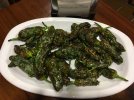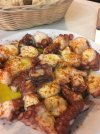- Time of past OR future Camino
- September 2024
What are the bests meals and drinks i need to try on my camino ?
| Remove ads on the forum by becoming a donating member. More here. |
|---|
That would be pollo, with two Ls.Im not sure why.. but i was expecting to see polos.. chicken
That's because you asked for suggestions on the best food. Chicken is commonly on the pilgrim menu which whilst adequate , even tasty sometimes is definitely not what I would call the 'best' food.Im not sure why.. but i was expecting to see polos.. chicken .. but that does not seem to be showing up…
Better " tortilla española" with potatoes and (onions). The other one is " tortilla francesa" which is the omelette.Be sure and try the tortilla de patatas (also known as tortilla de España). Many suggest trying the pulpo in Galicia.




bean stews are common across Spain, roasted lamb is a classic, fresh asparagus in Navarra, morcilla (blood sausage) in Burgos, botillo (I'll let you google that one) in Ponferrada, any kind of seafood across Spain (but we like to believe it's fresher in Galicia), salmorejo (from the south) will be around (tomato summer soup), so will gazpacho, hake is delicious, so is the trout, both will be prepared with regional recipes depending where you are, we eat a lot of fish, so indulge, manchego cheese, idiazabal cheese, ulloa-arzúa cheese, the bread is to die for, and there is always bread at your meal... and much more...What are the bests meals and drinks i need to try on my camino ?
This area is on Calle del Laurel, and it's definitely worth the cost of a pensión or hostal to be able to stay out late, then sleep in a bit after a tapas crawl.If you find yourself staying in Logrono, make sure to go out and enjoy the amazing variety of tapas available in their "tapas district".

I will agree, But try local foods wherever you are and always something new. It's also an adventure1I like the tarta de queso. Tortilla Español is also a favorite and pimento de Padron. In the winter I like Caldo Galego.

